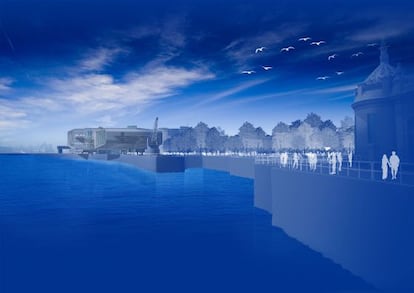Why Santander wants to be Bilbao
Architect Renzo Piano outlines his vision for the Botín Center The cultural venue, to be financed by the city’s famous banking son, is causing controversy


The gray skies that often cover Santander are the perfect mantle for the future Botín Center, according to its architect, Renzo Piano. The building will substantially change the cityscape of this quintessentially northern town, which will shine with all of its “generous” splendor thanks to that silvery light coming from the heavens.
“It is no longer time for excesses nor for rhetoric in architecture,” said Piano in the city last week. “This crisis is bad for men but good for buildings; it will make them more moral, more wise and more honest.” Once completed, the building will be a projecting structure that is literally suspended in the air and opens out to sea. Its surface will be covered with 360,000 pieces of ceramic of a pearly color. Its creator claims that there is no arrogance anywhere in it.
“It is not a large building,” says the Genoese architect during a conversation with EL PAÍS. “Its size and its budget are small; the main thing is its intensity, its tension, its poetry.”
Piano is a master in the use of materials that cannot be bought, such as the Atlantic light and the water that seeps unhurriedly into the bay of Santander — the two elements that conditioned his work. The ceramic covering was a last-minute decision after ruling out cement and metal.
“It is a traditional material that ages marvelously,” he notes.
The Italian provided these details after the banker Emilio Botín, chairman of Grupo Santander, offered other data in a rather less poetic manner: the center will cost 77 million euros, will be completed in 20 months, will create 1,400 jobs and handle an annual budget of more than 12 million euros. The hope is that the Botín Center will welcome around 200,000 visitors a year. “This is our most social project, the one with the biggest capacity to create cultural and economic wealth,” said Botín, 77, with some pride.
Outside the presentation, a dozen protesters banged on pots and pans to draw media attention to what they see as a harmful project for the bay. In recent months locals’ complaints have resulted in two major changes to the building. First, its location has been moved to preserve the Grúa de Piedra, an old harbor crane that is now an icon of the port area, and which was initially going to be taken elsewhere. Secondly, there will no longer be a bridge connecting the center and the harbor, but a tunnel that will take traffic underground and leave room for a new park in the city.
To Piano, these alterations are not concessions, but rather part of the logical confrontation between architects and the cities where their ideas take shape. Born to a builder who probably passed on his own pragmatism to his son, Piano stands firm before the storms.
“I grew up in the 1960s. I am accustomed to noise and controversy,” he explains. “We need debates, even if they are irritating, or even better if they are. [...] I have listened to all the citizens, and not just those who screamed. All the ideas were important, but listening does not mean obeying. In the end, you do what you feel you have to do.”
The future Centro Botín clearly seeks to reproduce the “Bilbao effect,” brought about by Frank Gehry’s avant-garde Guggenheim museum building. When it is completed, Santander will join a northern axis of modern architecture made up by the Kursaal in San Sebastián (by Rafael Moneo), the Niemeyer Center in Avilés (by Oscar Niemeyer) and the Guggenheim Bilbao.
Piano, who co-created the Pompidou Center in Paris with Richard Rogers in the 1970s, said that to him this is not a competition. “Nobody thinks about being better than anybody else, just about making a good, beautiful building. There is no competition, just loyalty to what you’re doing.”
A supporter of architecture as public art, which he feels is of no value if people do not incorporate it into their lives, Piano (whose Shard Tower in London, the tallest in Europe, has also triggered controversy) holds that every building has a story to tell. “Being an architect is a risky profession; mistakes are there to stay, but you need to take risks,” he said. “Buildings are like children. You have to wait for them to start walking to see what will become of them, to know whether they will finally be accepted. At first, cities resist change, but every city is a big invention and I am here to find new and different stories to tell, not to repeat the same old story over and over again.”
Tu suscripción se está usando en otro dispositivo
¿Quieres añadir otro usuario a tu suscripción?
Si continúas leyendo en este dispositivo, no se podrá leer en el otro.
FlechaTu suscripción se está usando en otro dispositivo y solo puedes acceder a EL PAÍS desde un dispositivo a la vez.
Si quieres compartir tu cuenta, cambia tu suscripción a la modalidad Premium, así podrás añadir otro usuario. Cada uno accederá con su propia cuenta de email, lo que os permitirá personalizar vuestra experiencia en EL PAÍS.
¿Tienes una suscripción de empresa? Accede aquí para contratar más cuentas.
En el caso de no saber quién está usando tu cuenta, te recomendamos cambiar tu contraseña aquí.
Si decides continuar compartiendo tu cuenta, este mensaje se mostrará en tu dispositivo y en el de la otra persona que está usando tu cuenta de forma indefinida, afectando a tu experiencia de lectura. Puedes consultar aquí los términos y condiciones de la suscripción digital.
Últimas noticias
Maduro pleads not guilty before the federal court in New York: ‘I am still the president of Venezuela’
A new test can detect Alzheimer’s from a finger prick
UN team enters Sudanese city of El Fasher after paramilitary massacre: ‘It’s like a ghost town’
A recipe for resistance: Indigenous peoples politicize their struggles from the kitchen
Most viewed
- Gilles Lipovetsky: ‘If you want to live better and fall in love, take Prozac, don’t look to philosophy’
- Alain Aspect, Nobel laureate in physics: ‘Einstein was so smart that he would have had to recognize quantum entanglement’
- Maduro’s downfall puts China’s relationship with Venezuela to the test
- Why oil has been at the center of Venezuela-US conflicts for decades
- Alvin Hellerstein, a 92-year-old judge appointed by Bill Clinton, to preside over Maduro’s trial in New York








































